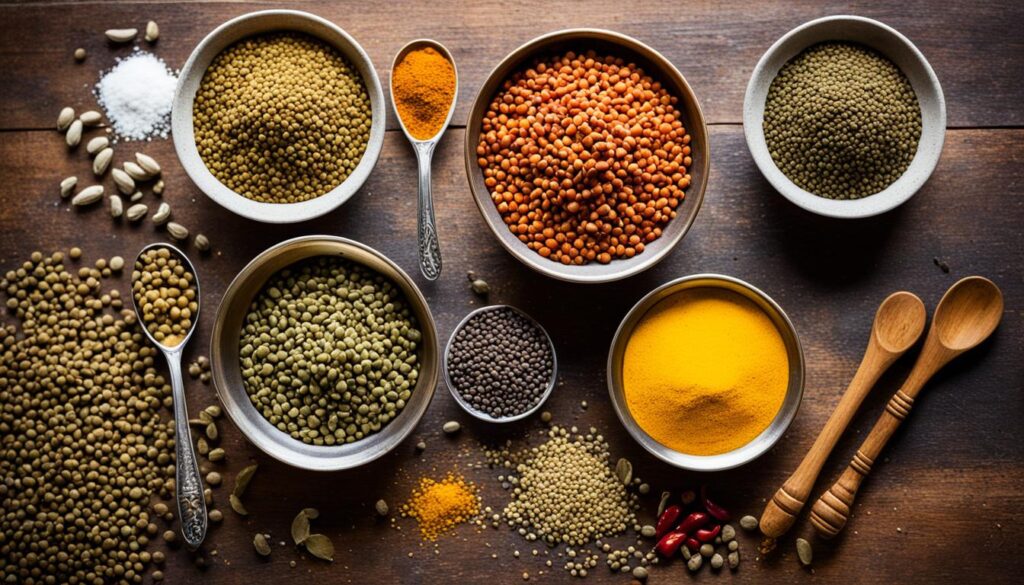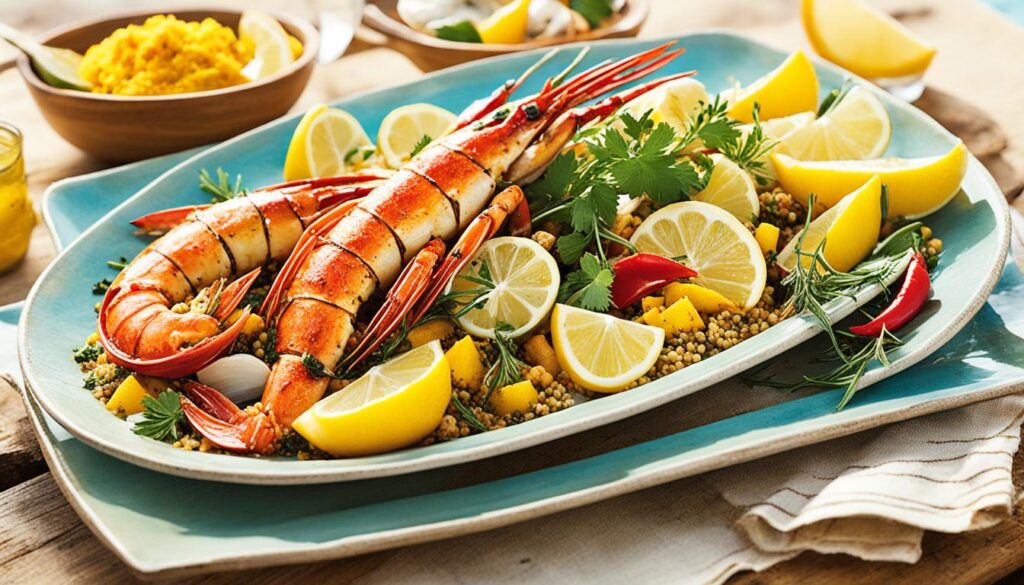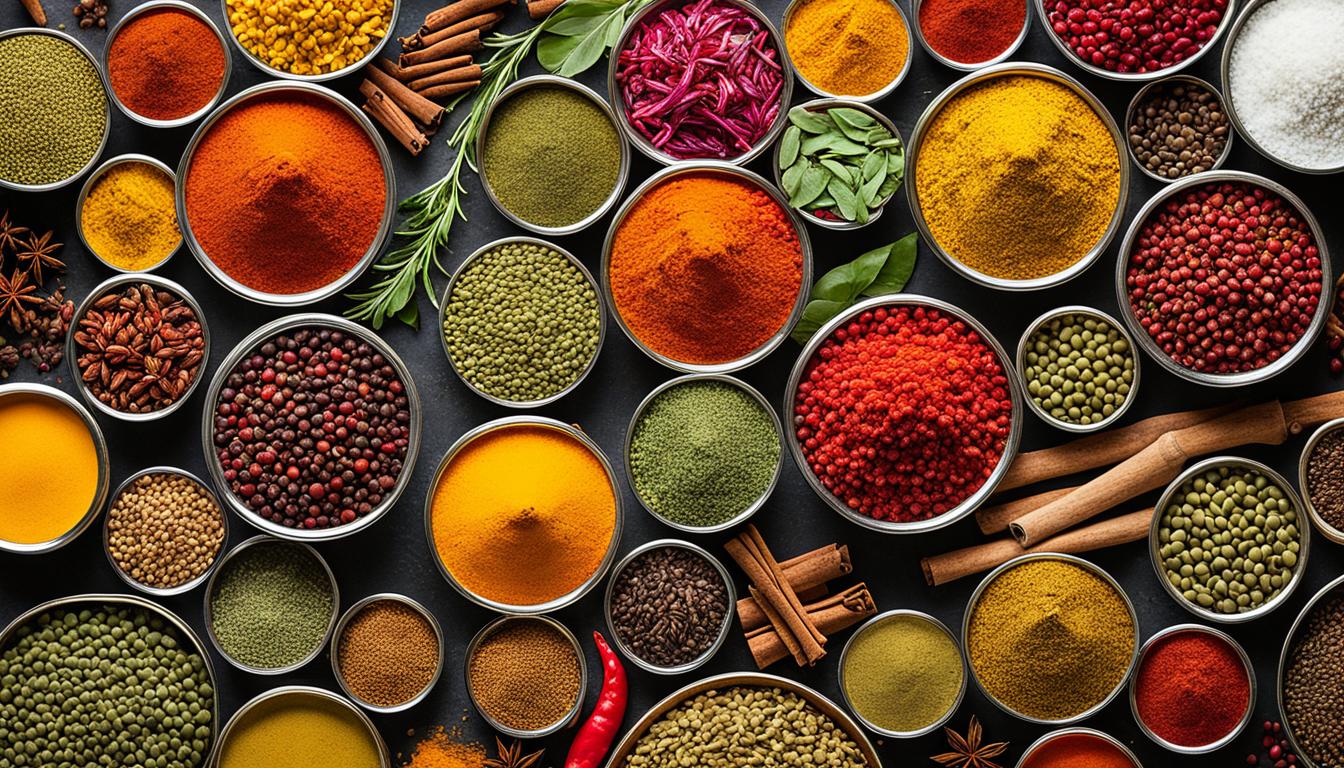Welcome to a flavorful journey through the vibrant world of Indian cooking! Have you ever wondered what makes Indian cuisine so rich and aromatic? What are the key ingredients that bring authentic flavors to Indian dishes? Today, we will unravel the mysteries of the Indian pantry and delve into the essential spices and dal varieties that every Indian home cook should have. So, are you ready to spice up your culinary repertoire and explore the diverse flavors of India?
India’s diverse and vast culinary landscape is reflected in its wide array of spices and dal varieties. From region to region, the spices used and the types of dal vary, creating unique flavors and dishes. To explore the essential spices and dal varieties that are a must in every Indian pantry, we consulted cookbook authors Raghavan Iyer and Chitra Agrawal. Let’s dive into the vibrant world of Indian cooking and discover the key ingredients that bring authentic flavors to your dishes.
The Role of Spices in Indian Cooking
Spices play an integral role in Indian cuisine, enhancing the flavor and complexity of dishes. In our Indian pantry, we stock several essential spices that are must-haves. These include cayenne, cumin, fennel, coriander, cinnamon sticks, cloves, star anise, black peppercorns, and bay leaves. These spices form the foundation of Indian cooking, adding depth and character to a wide range of recipes.
Different regions of India have their unique spice blends that are essential in their traditional dishes. In the North, garam masala is a common spice blend that adds warmth and aroma to curries and meat dishes. In the South, sambar powder is a must-have, imparting a distinct flavor to lentil stews and vegetable preparations. And in the East, panch phoron, a blend of five spices, creates a fragrant base for curries and stir-fries.
To ensure the best flavor, we recommend buying whole spices and grinding them fresh when needed. This allows the spices to release their full aroma and intensity. Remember to store your spices in a cool, dark place to preserve their potency and extend their shelf life.
img src=”https://seowriting.ai/32_6.png” alt=”essential indian spices”>
Having these essential Indian spices on hand will enable you to create authentic and flavorful Indian dishes in your own kitchen. Let’s continue exploring the vibrant world of Indian cooking!
Exploring Unique Spices
In addition to the essential spices, we can explore a few unique spices that add distinctive flavors to Indian dishes.
Turmeric
Turmeric is a vibrant yellow spice that is used in a wide range of Indian recipes. Not only does it add a beautiful color to dishes but it also has multiple health benefits. It is known for its anti-inflammatory properties and is believed to boost immunity.
Asafetida
Asafetida, also known as hing, is a pungent spice that is used primarily in Brahmin and Jain kitchens as a substitute for onion and garlic. It adds a unique flavor to dishes and is particularly popular in vegetarian cooking.
Mustard Seeds
Both brown and yellow mustard seeds are commonly used in South Indian cooking. When heated in oil, they release a nutty flavor that enhances the overall taste of the dish. Mustard seeds are often used in tempering or tadka to add a distinct flavor to curries and chutneys.
Fenugreek
Fenugreek, available in both seed and leaf form, adds a bitter note to dishes. It is used in both North and South Indian cuisines, particularly in lentil dishes like dal. Fenugreek leaves, also known as methi, are used to enhance the flavor of various curries and stir-fries.
Cardamom
Cardamom, available in green and black varieties, is a versatile spice widely used in Indian cooking. It imparts a unique minty and citrusy flavor to both sweet and savory dishes. Cardamom is often used in desserts, chai tea, and meat dishes to add a delightful aroma and taste.
The Role of Souring Agents
Indian cuisine is known for its bold and balanced flavors, and one way that these flavors are achieved is through the use of souring agents. Sourcing souring agents are essential in creating the perfect balance of tanginess and acidity in Indian dishes.
The Versatile Amchur
One such souring agent is amchur, also known as dried green mango powder. Amchur is commonly used in Northern Indian cooking to add a delightful tanginess and subtle sweetness to curries, stews, and marinades. It retains the natural flavors of raw mangoes and enhances the overall taste of a dish. Whether you’re preparing aloo baingan or rajma masala, a sprinkle of amchur can elevate the flavors and make your dish truly memorable.
Tantalizing Tamarind
Tamarind is another popular souring agent used in Indian cuisine, especially in South Indian dishes. Its tart and tangy flavor adds a unique dimension to curries, chutneys, and even refreshing beverages. Tamarind is available in two forms – as a concentrate or in block form. To use tamarind, soak the required amount in hot water, and then extract the pulp, which can be added to your dish to achieve that characteristic tanginess.
The vibrant image above showcases the powerful impact of souring agents in Indian cooking, particularly the inclusion of mango powder – a crucial ingredient in amchur.
By incorporating these souring agents into your dishes, you can achieve a harmonious balance of flavors that will keep your taste buds constantly engaged. The tanginess of amchur and tamarind adds a unique and refreshing twist to traditional Indian recipes.
Exploring Essential Dal Varieties
Dals, or stew-like legume dishes, are a staple in Indian cuisine. They are not only nutritious but also packed with flavor. Let’s take a closer look at some of the essential dal varieties that play a prominent role in Indian cooking.
Toor Dal (Split Pigeon Peas)

Toor dal, also known as split pigeon peas, is the most commonly used lentil in South Indian cooking. It is known for its creamy texture and mild, nutty flavor. Toor dal is often used to make sambhar, a popular South Indian lentil soup, as well as various dal preparations.
Urad Dal (Black Gram)

Urad dal, or black gram, is a versatile dal variety that is popular in both North and South Indian cuisines. It has a creamy texture and a slightly earthy taste. Urad dal is commonly used in dishes like dal makhani, idli batter, and dosa batter, where it adds richness and depth of flavor.
Moong Dal (Split Mung Beans)

Moong dal, also known as split mung beans, is a light and easily digestible dal variety. It has a mild, nutty flavor and cooks relatively quickly. Moong dal is used in a variety of dishes, including soups, stews, khichdi, and desserts like moong dal halwa.
Masoor Dal (Split Red Lentils)

Masoor dal, or split red lentils, is a popular dal variety known for its quick cooking time and delicate flavor. It has a slightly sweet and nutty taste. Masoor dal is commonly used in North Indian dal preparations, soups, and curries.
Chana Dal (Split Bengal Gram)

Chana dal, or split Bengal gram, is a robust and rich dal variety with a slightly sweet and nutty taste. It holds its shape well when cooked and adds a delightful texture to dishes. Chana dal is often used in curries, soups, and traditional Indian sweets like besan ladoo.
Each dal variety brings its unique flavor and texture to Indian dishes, whether it’s the hearty toor dal in sambhar, the creamy urad dal in dal makhani, or the quick-cooking moong dal in khichdi. Experimenting with different dal varieties allows us to create a diverse range of delicious and satisfying meals.
Main Ingredients for Indian Breads
Indian cuisine boasts a wide variety of breads, each made with different ingredients. These breads serve as both a utensil and a delicious accompaniment to Indian dishes.
Naan: A wheat-based staple that originates from North India, naan is enjoyed with various curries and kebabs. It is a soft and fluffy bread that can be plain or stuffed with ingredients like garlic, cheese, or herbs. Naan is typically cooked in a tandoor, a traditional clay oven, which gives it a slightly charred and smoky flavor.
Dosas: Made from chickpea and rice flour, dosas are thin crepes that are popular in South India. They are typically served with coconut chutney and sambar, a lentil soup. Dosas come in a variety of flavors and textures, ranging from crispy and paper-thin to soft and spongy. They can be filled with ingredients like potatoes, onions, or paneer.
Bhakri: A specialty of Gujarat in Western India, bhakri is an unleavened bread made from sorghum flour. It is commonly enjoyed with a variety of Gujarati dishes, such as curries, pickles, and chutneys. Bhakri has a rustic and earthy flavor and is known for its crisp texture. It is often cooked on a tava, a flat griddle.
Different Types of Naan:
- Plain Naan
- Garlic Naan
- Butter Naan
- Cheese Naan
Popular Dosa Varieties:
- Plain Dosa
- Masala Dosa
- Rava Dosa
- Paper Dosa
Traditional Bhakri Flavors:
- Jowar Bhakri
- Bajra Bhakri
- Ragi Bhakri
The Influence of Regional Cuisines
Indian cuisine is greatly influenced by the regional diversity of the country. Each region has its own unique culinary traditions and flavors.
Northern Indian Cuisine
Northern Indian cuisine incorporates more dairy, with dishes like paneer and ghee being prominent. Creamy and rich, these dishes are a hallmark of the region’s gastronomy. The vibrant flavors of spices are used to create mouthwatering curries and gravies that are enjoyed with various breads like naan and paratha.
Coastal South Indian Cuisine
Coastal South Indian cuisine favors the use of tamarind for its tartness. This region’s cuisine is known for its spicy and tangy flavors, with dishes like sambar, rasam, and dosas being popular. Coconut is also prevalent, with coconut oil and coconut milk adding depth and richness to many dishes.

Coastal West Cuisine
The coastal West region, with its abundance of coconut palms, incorporates coconut oil and milk into many dishes. The cuisine of Goa, a state on the West coast of India, showcases a unique blend of Portuguese and Indian flavors. Seafood is a highlight of this region, with dishes like fish curry and prawn balchão being highly regarded.
Various religions and historical influences have also shaped Indian cuisine, resulting in a wide range of dishes and flavors. The culinary traditions of India are as diverse as its people, offering a delightful experience for food enthusiasts.
The Importance of Rice and Dal
Rice and dal are integral components of traditional Indian cuisine. Together, they form the foundation of many Indian meals, offering a complete protein source and a satisfying dining experience.
Indian pulse dishes, commonly known as dal, feature a variety of pulses such as chickpeas, red lentils, black-eyed peas, kidney beans, and yellow split peas. These pulses, combined with rice and flavorful spices, create hearty and nutritious meals.
Whether enjoyed alongside breads, mixed with rice, or savored as a standalone dish, rice and dal dishes offer versatility and can be customized to suit individual tastes and preferences.
As a homage to the rich culinary traditions of India, the combination of rice and dal is considered the heart of many Indian recipes, showcasing the diversity and depth of flavors that Indian cuisine has to offer.
Why rice and dal?
- Provide a complete protein source
- Satisfying and fulfilling meal
- Versatile and customizable
- Highlight the diversity of Indian flavors
Stocking Your Indian Pantry
To stock your Indian pantry, it is important to have the essential ingredients on hand. Rice, lentils, beans, shredded coconut, coconut milk, ghee, yogurt, and a range of spices are key components of an Indian pantry. These ingredients form the foundation of Indian cooking and allow you to create a wide variety of authentic dishes. Having these staples readily available will make cooking Indian food a breeze.
Conclusion
Stocking your Indian pantry with the essential ingredients is the key to unlocking the vibrant flavors of Indian cuisine. By having a wide range of spices like cayenne, cumin, and coriander, along with various dal varieties such as toor dal and urad dal, you can create delicious and authentic Indian dishes right in your own kitchen.
Whether you’re a beginner or an experienced cook, having these pantry essentials at your fingertips will elevate your culinary creations. With each spice and dal variety offering unique flavors and textures, you can explore the rich diversity of Indian cooking.
So, make sure your pantry is well-stocked with Indian cooking essentials. From the warm and aromatic spices to the hearty and nourishing dals, these pantry staples are the foundation of Indian cuisine. Embrace the culinary traditions of India, and let your kitchen come alive with the enticing aromas and flavors of authentic Indian meals.
